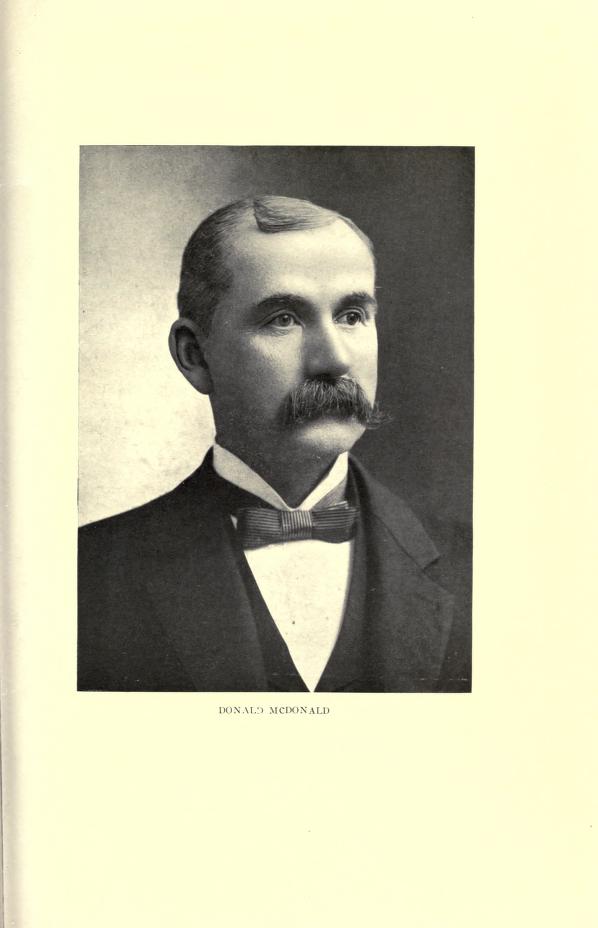Donald McDonald, born in Canada in 1850 to Scottish parents, moved to Dubuque County, Iowa, where his family engaged in farming and milling. In 1878, he settled in Grand Forks, North Dakota. He purchased the Grand Forks “Plaindealer” newspaper shortly after his arrival, successfully running it for two years before selling it. In 1879, McDonald was appointed postmaster, overseeing the growth of the post office from fourth to second-class. He witnessed the evolution of mail transportation, from stagecoaches to railway service. After leaving the post office, McDonald ventured into various business endeavors, including undertaking and tent/awning manufacturing. In 1906, he was elected county treasurer, a position he currently holds.
Donald McDonald. — The subject of this sketch is of Scotch descent. His parents, Duncan McDonald and Janet McIntosh, both being from the Highlands. They emigrated to Canada in early life. Donald was born in that country in 1850. The following year the family moved to Dubuque County, Iowa, where they engaged in the farming and milling business. The father died in 1858, and in 1863 the mother with the family moved to Butler County in the same state. Mr. McDonald’s early years were spent in this section. In 1873, imbued with the same spirit as most western boys, he went to South Dakota, spending a few years there, and in 1878 came to Grand Forks, where he has since resided. He was married in Iowa in 1876 to Addie Leete, whose death occurred in September 1904. He has two sons, Dr. A. L. McDonald, of the University, and Bruce, aged sixteen, a student in the high school.
Shortly after coming to Grand Forks, Mr. McDonald bought from George H. Walsh the only newspaper then in the north half of the state, the Grand Forks Plaindealer. This he successfully published for two years, when he sold it. In April 1879, he was appointed postmaster, holding the office until June 1888. During his term, the post office grew from a fourth to a second-class, and he had the novel experience of having received mail by all of the well-known methods of carriage, dog train, horseback, stage coach, steamboat, and railway. At first, the mail, that is the mail from and to the East, was carried by stage on the old Fargo-Pembina route. At this day it seems like a long journey to Fargo by team, but the old Blakely-Carpenter Company, and later the Gilmer-Salisbury people, used to make the distance in fifteen hours, so that we were only about twelve hours farther from the Twin Cities than we are now. The St. Paul, Minneapolis & Manitoba Railway, built to the east side of the river in the fall of 1879, and railway mail service began on December 1 of that year. Mail was, however, carried along the old stage route until 1882, when the building of the lines of railroad on the west side of the Red River made the star route service no longer necessary. In October 1879, the late Senator W. N. Roach opened up the route between this city and Fort Totten. The following winter, 1879-80, was one of the most severe in the history of the country, and Mr. Roach was obliged to resort to everything possible in order to get the mail through and tried all of the frontier methods, and was successful in keeping the route open.
The post office became presidential in 1880, and Mr. McDonald was commissioned by President Hayes and later in 1884 by President Arthur. After retiring from the post office, he engaged in business in the city. For the past few years, he has conducted an undertaking establishment, which he sold out in January 1907. At present, his regular business is the manufacture of tents and awnings. In 1906, he was elected county treasurer, a position which he now holds.
Source
C.F. Cooper & Company, History of the Red River Valley, Past And Present: Including an Account of the Counties, Cities, Towns And Villages of the Valley From the Time of Their First Settlement And Formation, volumes 1-2; Grand Forks: Herald printing company, 1909.

